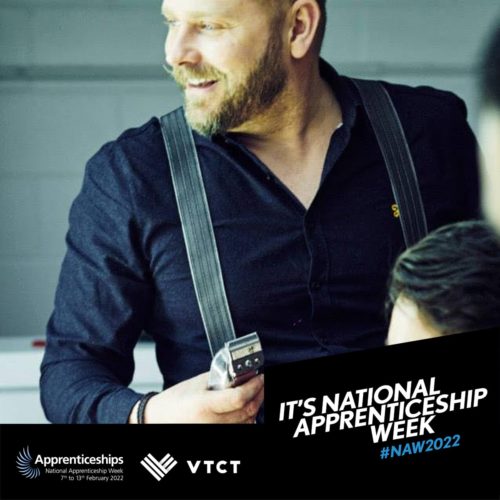
Award-winning barbers and training providers, Mike Taylor Education, have gone from strength to strength since they were established over ten years ago. Mike and his team are proud to be a thriving VTCT centre that supports apprentices with a passion for the barbering industry.
In honour of National Apprenticeship Week 2022, Mike told us everything you need to know about apprenticeships from a training provider perspective.

As the training provider, we are responsible for delivering high-quality apprenticeship training that meets the needs of both the apprentice and the employer. It is our responsibility to deliver the off-the-job training required to ensure the apprentice can complete their end-point assessment. As part of the off-the-job training, we also ensure that the knowledge, skills and behaviours of the apprentice are developed to the standard required by the employer and the apprenticeship standard.
Alongside the off-the-job training, we also deliver Maths and English (if required) and are responsible for the safeguarding of the apprentices, so it is important that our academy is inclusive and protects the wellbeing of all learners and educators.
 How do you work with employers to support the apprentice?
How do you work with employers to support the apprentice?We work closely with our employers to ensure that we can work together to support the apprentice. As well as employers being heavily involved in the enrolment process, we also conduct 12 weekly reviews with all of our apprentices and employers to make sure that we continue to work together throughout the apprenticeship programme and continue to develop the apprentices together.
At Mike Taylor Education, we also host an annual Inspiration Day where we invite leading external educators to provide training workshops for our apprentices and employers. This is a great opportunity for employers and apprentices to get additional training, be inspired and motivated, come along to our academy, meet our team and discuss the apprenticeship.
Most of our new employers come on board through word of mouth recommendations and the quality associated with Mike Taylor Education. We have 100% first time Pass or Distinction grades at end-point assessment for our apprentices and employers can rest assured that we can deliver quality training.
We also meet new employers at industry events such as Salon International, BarberFest and our Great British Barbering Academy Tour in Poole. These are great to meet new employers, discuss face to face what we can offer and how we can work together.
At Mike Taylor Education, we offer both academy-based and work-based training or a mixture of both. All of our apprentices must complete 20% off-the-job training and this is all logged online.
Some employers like their apprentices to come to the academy every week, some prefer their apprentices to stay in the shop and conduct their own training days,and others prefer a mix of both. The most important thing is that we work with the employer and the apprentice and offer flexible training that suits each individual workplace. What works for one won’t work for another.

An apprenticeship is arguably the best route into the industry. You get the benefit of in-house training from a salon or barbershop alongside gaining a recognised qualification from a training provider. The new end-point assessments have really tightened and improved the quality around apprenticeships because an independent end-point assessor will assess the skills, knowledge and behaviours through practical observations and oral questioning.
In recent years, young people don’t have the opportunities that kids had years ago – there are very few paper rounds, milk rounds, Saturday jobs etc. so an apprenticeship is often the very first experience young people have of work. Because of this, apprentices can start very inexperienced with working life and general life skills. A lot of the time, we have to spend some time at the beginning teaching very basic skills such as making tea and coffee, greeting clients, answering the phone, folding towels etc.
The best route into an apprenticeship is through a Traineeship Programme. These are designed to prepare 16 – 24 year olds for work as an apprentice. They combine practical training with work experience so are a great step in the right direction. The training builds learners confidence and competence with the tasks they will be required to do as an apprentice whilst the work placement can get trainees a foot in the door of a salon or barbershop. If they can prove themselves throughout their work placement then they may be offered an apprenticeship position.
We have been delivering traineeships for about 18 months now and around 80% progress into an apprenticeship position which is amazing.
![]()